STUDENTS PROJECTS
2010
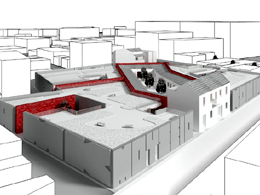
10 February, 2011
ATHENS COMICS MUSEUM at Gkazi
...A new cultural centre was created from the industrial area remains and the modern graffiti designs in order to host and promote the art of comics.
Student: Rebi Euaggelia
Supervisor: Panos Dragonas
University of Patras, School of Engineering, Department of Architecture
Submission Date: June 2010
The aim of this thesis is to create a Comics Museum located in Gkazi while conserving the local characteristics of the area. Gkazi used to be in the past an industrial area. Remnants of this age are the low buildings with the old Athenian courtyards. The combination of these characteristics with a series of new cultural and graffiti spaces synthesize the structure of the proposed Comics Museum. By that, Greek and foreign comic designers will have their own cultural centre in order to promote their art and participate in cultural events.
The groundwork for the selection of the specific topic emerged from a research report that was investigating the relationship between architecture and the art of comics. However, the main initiative behind the study of the creation of a Comics Museum was the shortness of spaces, both in Athens and in Greece generally, where the art of comics could be expressed.
Gkazi is the ideal area where the Comics Museum can be hosted. The recent development which took place at Gkazi was based on the creation of multi cultural and entertainment spaces. The creation of cultural centres can play an important role in the development and enhancement of the cultural character of Gkazi. Therefore, the Comics Museum could attract visitors (by exhibitions, festivals and concerts), and generate a space which has a distinctive cultural role and can discourage the dominance of the night industry and commercialization.
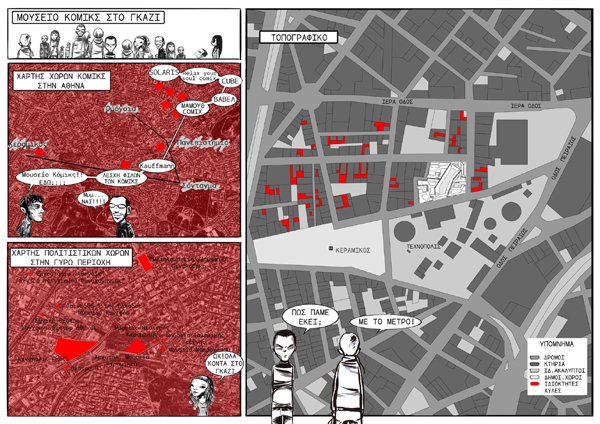
Gkazi in the old days, used to be a districts of Athens which was mainly inhabited by refugees, a typical labour settlement with one or two-storey residences. On the block of intervention, three abandoned buildings are fully maintained as well as certain individual walls from buildings which were found in structural condition. In the vacant spaces three new volumes are added that are shaped in dialogue with the old buildings. The new volumes are characterized by simplicity of design with limited openings to the street. The introversion of the new complex gives a sense of mystery, challenging the passengers to explore it. The construction materials are differentiated between the old and the new buildings. For the new interventions the selected materials are glass, cast concrete and industrial floorings while in the existing buildings stone and timber are maintained.

The Museum complex is divided in 5 sections:
• Reception and exhibition areas
• Recreation areas including a café and a gift shop
• Administration and secondary areas
• Accommodation areas
• Educational spaces
A fundamental design decision was the creation of platforms-courtyards that receive and guide the visitor to the inside of the Museum giving the sence of an old neighborhood. Simultaneously, these multiple platforms-courtyards create a network of movement which serves the operation of individual departments of the museum 24 hours per day.
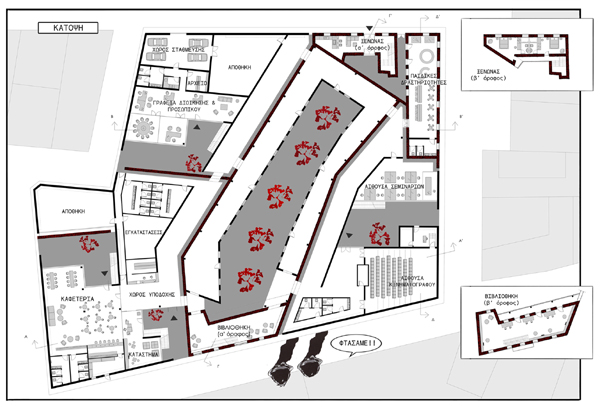
The exhibition spaces are placed centrally in the block of intervention, occupying parts of both new and old buildings. Two basic corridors are created where the exhibits are being displayed. For the new sections of the museum glass is used as a primary material. The glass surfaces are offset 60cm from the old stone walls, allowing the natural light to enter. Additionally, when the visitor within the new section of the museum, apart from the exhibits on the glass surfaces, he/she can also perceive the old walls being exposed behind the glass.
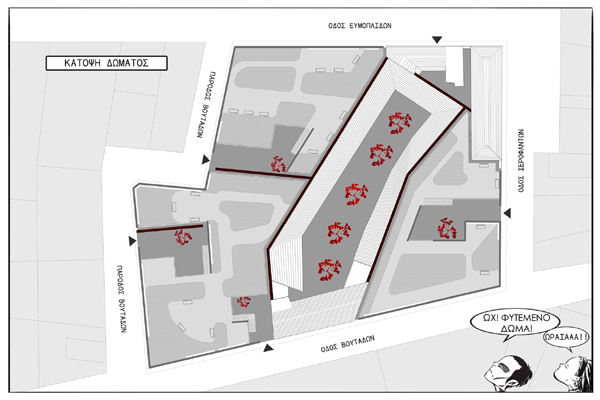
The museum contains a number of green spaces which can be found at two different levels. Those areas are offered for gatherings and discussions. The main green forecourt in the ground floor is particularly functional. It is a place of rest but it can also give the possibility to the visitor to select the sections of exhibits he/she is going to visit. The transition between the exterior and the interior of the Museum is served with successive openings (one every 3 meters) which maintain a constant rhythm that refers to the morphology of the old labour residences.
Natural light is used extensively in the interior of the Museum, according to the function of each space. This is achieved by the use of multiple openings facing the courtyards, small openings placed on the main building facades and skylights. The skylights have been placed in specific parts of the roof so that the configuration of the loft is not affected. The loft has low vegetation, various resting areas and is also used for three-dimensional projections of comics' heroes.
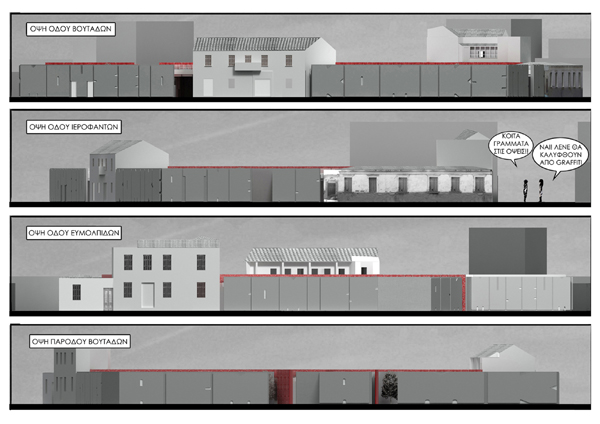
The building facades are shaped with letters that describe the function of the Museum. "MUSEUM COMIC ATHENS COMICS MUSEUM ACM AMK". The letters on the facades of the building complex can be considered as an empty canvas for graffiti designers. Through the apertures that the letters create on the building facade, natural light enters the interior during the day, and during night the artificial lighting of the museum creates an impressive visual effect.
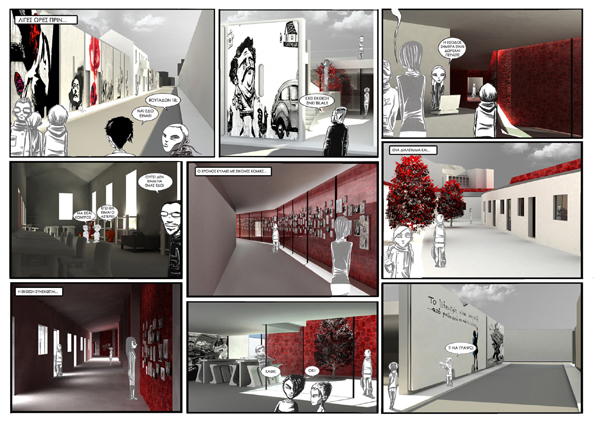
*The comics' figures that are used in this thesis are mainly taken from the series COMMON COMICS by Panagiotis Pantazis.
Related articles:
- UNDERGROUND MUSEUM IN PALIOURI DIMINIOU OF PHYSICAL DISCIPLINE AND BODY INCARCERATION ( 26 August, 2007 )
- Moderna Museet Malmö ( 10 May, 2010 )
- NEW PATRAS MUSEUM ( 12 October, 2009 )
- NATIONAL RESISTANCE MUSEUM AND MONUMENT TO ELECTRA APOSTOLOU IN NEON HERAKLEION, ATHENS ( 19 October, 2009 )
- Small mining museum and centre of environmental research in Itea. ( 17 July, 2010 )
- 3rd Prize for a Greek entry in an international architectural competition ( 20 September, 2010 )
- Costume Culture Museum ( 10 February, 2011 )
- Stone Bridge Museum ( 18 September, 2012 )
- “Urban intervention network in Plato’s Academy_A Museum of the city of Athens proposal” ( 10 April, 2011 )
- Transformation of the warehouse of tobacco Papapetrou in an Archeological museum of Aitoloakarnanias and cultural centre of Agrinio ( 08 May, 2011 )
- Los Angeles Museum of the Holocaust ( 15 June, 2011 )
- Archaeological Museum of Arta ( 12 August, 2013 )
- "Earth Museum" ( 05 January, 2012 )
- Venetian Arsnals of Chania ( 24 January, 2012 )
- New Taipei City Museum of Art, Conceptual Design International Competition August 2011 ( 08 February, 2012 )
- Mining Museum in Serifos ( 15 February, 2012 )
- Riverside Clubhouse ( 10 March, 2012 )
- New Glasgow Riverside Museum of Transport ( 24 April, 2012 )
- Enzo Ferrari Museum ( 23 April, 2012 )
- Bunker 599 603 ( 06 May, 2012 )
- Heidelberg Castle’s new Visitor Center ( 24 May, 2012 )
- Grand Egyptian Museum in Cairo ( 22 January, 2013 )
- Guggenheim Museum in Helsinki ( 22 March, 2013 )
- Noesis. Interactive Museum ( 20 May, 2013 )
- Danish National Maritime Museum ( 28 November, 2013 )
- Redefining Leftovers ( 05 April, 2014 )
- Cultural center of Glyfada ( 23 February, 2014 )
- The rack railway museum at Vouraikos gorge ( 18 April, 2014 )
- Historical and Folklore Museum of Nikiti ( 17 February, 2017 )










